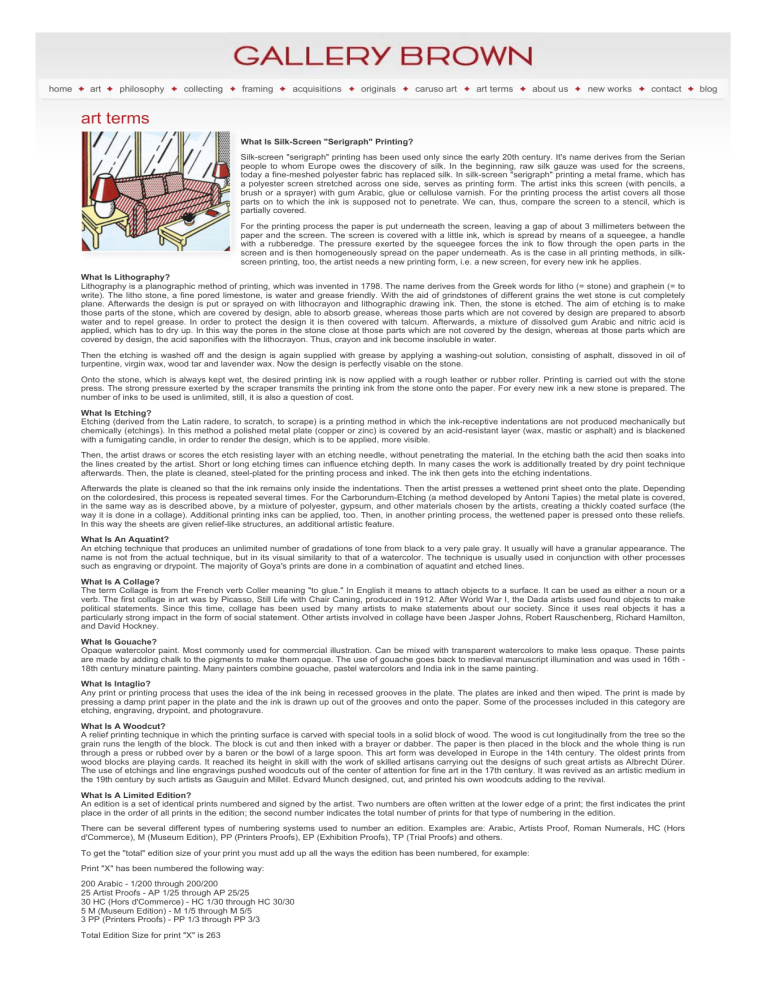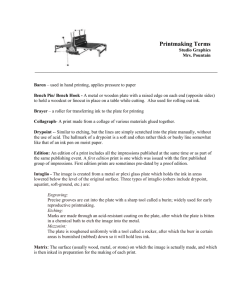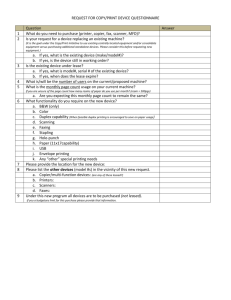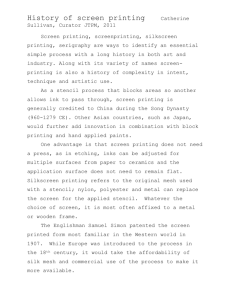art terms

home art philosophy collecting framing acquisitions originals caruso art art terms about us new works contact blog
art terms
What Is Silk-Screen "Serigraph" Printing?
Silk-screen "serigraph" printing has been used only since the early 20th century. It's name derives from the Serian people to whom Europe owes the discovery of silk. In the beginning, raw silk gauze was used for the screens, today a fine-meshed polyester fabric has replaced silk. In silk-screen "serigraph" printing a metal frame, which has a polyester screen stretched across one side, serves as printing form. The artist inks this screen (with pencils, a brush or a sprayer) with gum Arabic, glue or cellulose varnish. For the printing process the artist covers all those parts on to which the ink is supposed not to penetrate. We can, thus, compare the screen to a stencil, which is partially covered.
For the printing process the paper is put underneath the screen, leaving a gap of about 3 millimeters between the paper and the screen. The screen is covered with a little ink, which is spread by means of a squeegee, a handle with a rubberedge. The pressure exerted by the squeegee forces the ink to flow through the open parts in the screen and is then homogeneously spread on the paper underneath. As is the case in all printing methods, in silkscreen printing, too, the artist needs a new printing form, i.e. a new screen, for every new ink he applies.
What Is Lithography?
Lithography is a planographic method of printing, which was invented in 1798. The name derives from the Greek words for litho (= stone) and graphein (= to write). The litho stone, a fine pored limestone, is water and grease friendly. With the aid of grindstones of different grains the wet stone is cut completely plane. Afterwards the design is put or sprayed on with lithocrayon and lithographic drawing ink. Then, the stone is etched. The aim of etching is to make those parts of the stone, which are covered by design, able to absorb grease, whereas those parts which are not covered by design are prepared to absorb water and to repel grease. In order to protect the design it is then covered with talcum. Afterwards, a mixture of dissolved gum Arabic and nitric acid is applied, which has to dry up. In this way the pores in the stone close at those parts which are not covered by the design, whereas at those parts which are covered by design, the acid saponifies with the lithocrayon. Thus, crayon and ink become insoluble in water.
Then the etching is washed off and the design is again supplied with grease by applying a washing-out solution, consisting of asphalt, dissoved in oil of turpentine, virgin wax, wood tar and lavender wax. Now the design is perfectly visable on the stone.
Onto the stone, which is always kept wet, the desired printing ink is now applied with a rough leather or rubber roller. Printing is carried out with the stone press. The strong pressure exerted by the scraper transmits the printing ink from the stone onto the paper. For every new ink a new stone is prepared. The number of inks to be used is unlimited, still, it is also a question of cost.
What Is Etching?
Etching (derived from the Latin radere, to scratch, to scrape) is a printing method in which the ink-receptive indentations are not produced mechanically but chemically (etchings). In this method a polished metal plate (copper or zinc) is covered by an acid-resistant layer (wax, mastic or asphalt) and is blackened with a fumigating candle, in order to render the design, which is to be applied, more visible.
Then, the artist draws or scores the etch resisting layer with an etching needle, without penetrating the material. In the etching bath the acid then soaks into the lines created by the artist. Short or long etching times can influence etching depth. In many cases the work is additionally treated by dry point technique afterwards. Then, the plate is cleaned, steel-plated for the printing process and inked. The ink then gets into the etching indentations.
Afterwards the plate is cleaned so that the ink remains only inside the indentations. Then the artist presses a wettened print sheet onto the plate. Depending on the colordesired, this process is repeated several times. For the Carborundum-Etching (a method developed by Antoni Tapies) the metal plate is covered, in the same way as is described above, by a mixture of polyester, gypsum, and other materials chosen by the artists, creating a thickly coated surface (the way it is done in a collage). Additional printing inks can be applied, too. Then, in another printing process, the wettened paper is pressed onto these reliefs.
In this way the sheets are given relief-like structures, an additional artistic feature.
What Is An Aquatint?
An etching technique that produces an unlimited number of gradations of tone from black to a very pale gray. It usually will have a granular appearance. The name is not from the actual technique, but in its visual similarity to that of a watercolor. The technique is usually used in conjunction with other processes such as engraving or drypoint. The majority of Goya's prints are done in a combination of aquatint and etched lines.
What Is A Collage?
The term Collage is from the French verb Coller meaning "to glue." In English it means to attach objects to a surface. It can be used as either a noun or a verb. The first collage in art was by Picasso, Still Life with Chair Caning, produced in 1912. After World War I, the Dada artists used found objects to make political statements. Since this time, collage has been used by many artists to make statements about our society. Since it uses real objects it has a particularly strong impact in the form of social statement. Other artists involved in collage have been Jasper Johns, Robert Rauschenberg, Richard Hamilton, and David Hockney.
What Is Gouache?
Opaque watercolor paint. Most commonly used for commercial illustration. Can be mixed with transparent watercolors to make less opaque. These paints are made by adding chalk to the pigments to make them opaque. The use of gouache goes back to medieval manuscript illumination and was used in 16th -
18th century minature painting. Many painters combine gouache, pastel watercolors and India ink in the same painting.
What Is Intaglio?
Any print or printing process that uses the idea of the ink being in recessed grooves in the plate. The plates are inked and then wiped. The print is made by pressing a damp print paper in the plate and the ink is drawn up out of the grooves and onto the paper. Some of the processes included in this category are etching, engraving, drypoint, and photogravure.
What Is A Woodcut?
A relief printing technique in which the printing surface is carved with special tools in a solid block of wood. The wood is cut longitudinally from the tree so the grain runs the length of the block. The block is cut and then inked with a brayer or dabber. The paper is then placed in the block and the whole thing is run through a press or rubbed over by a baren or the bowl of a large spoon. This art form was developed in Europe in the 14th century. The oldest prints from wood blocks are playing cards. It reached its height in skill with the work of skilled artisans carrying out the designs of such great artists as Albrecht Dürer.
The use of etchings and line engravings pushed woodcuts out of the center of attention for fine art in the 17th century. It was revived as an artistic medium in the 19th century by such artists as Gauguin and Millet. Edvard Munch designed, cut, and printed his own woodcuts adding to the revival.
What Is A Limited Edition?
An edition is a set of identical prints numbered and signed by the artist. Two numbers are often written at the lower edge of a print; the first indicates the print place in the order of all prints in the edition; the second number indicates the total number of prints for that type of numbering in the edition.
There can be several different types of numbering systems used to number an edition. Examples are: Arabic, Artists Proof, Roman Numerals, HC (Hors d'Commerce), M (Museum Edition), PP (Printers Proofs), EP (Exhibition Proofs), TP (Trial Proofs) and others.
To get the "total" edition size of your print you must add up all the ways the edition has been numbered, for example:
Print "X" has been numbered the following way:
200 Arabic - 1/200 through 200/200
25 Artist Proofs - AP 1/25 through AP 25/25
30 HC (Hors d'Commerce) - HC 1/30 through HC 30/30
5 M (Museum Edition) - M 1/5 through M 5/5
3 PP (Printers Proofs) - PP 1/3 through PP 3/3
Total Edition Size for print "X" is 263
What Is A Giclee?
(Pronounced - Gee-Clay)
The word giclee is French for "to spray" and was given to the method of plate-less fine art printing developed in 1989. It is also the registered trade name for the Iris Printer. Images are scanned and stored digitally by computer then sent to a high resolution printer. The ink is then sprayed onto paper or canvas mounted onto a drum which rotates as the inks are applied. Very high resolution reproductions can be obtained using this method of printing.
Remarque:
A sketch made by the artist on the margin of the print - sometimes in black or colored pencil or watercolor.
Bas-Relief:
A low relief sculpture that projects only slightly from its two dimensional background.
Bronze:
An alloy of copper and tin used for sculpture.
Example of Limited Edition Numbers:
Arabic Numbers - Arabic numbers refer to our own system of numbers 0 - 9. An arabic numbered piece would be a fraction such as 1/150 - the top number denoting the sequence in the edition, the bottom number denoting the total number of prints in the arabic edition.
Roman Numerals - Roman numbers would also be shown as a fraction when numbered on the artwork such as: II/C the top number denoting the sequence in the edition, the bottom number denoting the total number of prints in the roman numeral edition.
Artist Proof - ADDITIONAL PROOFS FROM A PRINT RUN THAT CAN EITHER BE INCLUDED IN THE REGULAR EDITION OR PULLED FOR THE
ARTISTS APPROVAL AND RETAINED FOR HIS PERSONAL USE. Artists proofs can be marked AP either with or without a number that denotes how many were run. Example AP or AP 1/50 OR AP I/L.
Hors d' Commerce - This French term means "before business". Originally Hors Commerce prints were used as the color key and printing guide for the printer to insure consistency of the run. In modern serigraphy that are usually used to extend the numbering of the run. The letters HC can be used either with or without a number that denotes how many were run. EXAMPLE HC OR HC 1/100 OR HC I/C.
Trial Proof - A Trial Proof originally was used in a similar fashion as the Hors Commerce - as a guide to the printer before printing the edition. Trial proofs can also be different colored prints than those used in the regular edition. Andy Warhol frequently added Trial proofs in addition to his regular pieces where varied colors were used in the body of the image and the background. The letters TP can be used either with or without a number that denotes how many were run. Example TP or TP 1/50 OR TP I/L. Pieces numbered TRIAL PROOF can be used as an extension of the regular run or they can be entirely different colors from the regular run.
Bon a Tirer: This is a french term which translates as "good pull". It denotes that the print that has just been pulled can be used as a guide to match up the remainder of the prints that are pulled in the edition.
Plate Signed: Prints in which the artist's signature is put onto the plate itself and then transferred to the print through the same process as the rest of the design.
Collotype: A photographic printing process in which a glass plate whose surface has been coated with gelatin carries the image to be reproduced.
Monoprint: One of a series of prints in which each has some differences of color, design, texture, etc applied to an underlying common image.
Monotype: One of a kind print made by painting on a smooth metal, glass or stone plate and then printing on paper - the pressure of printing creates a texture not possible when painting directly on paper (not to be confused with a mono-print).
address: 140 s. orlando avenue, Los Angeles, CA. 90048 visiting hours: Tuesday – Friday 11-5 and Saturday by Appt only phone: 323.651.1956 fax: 323.658.6575
© 2008 Gallery Brown





